
-
1.
-
2.
-
3.
-
4.
-
5.
Surfing is an exhilarating sport, but one which should not be taken lightly. If you are out in open waters with only a board to get you back to the shore, you should make sure that you have planned everything and have all the equipment you need. In relation to this, a well-fitting surfing wetsuit is very important to have, especially if you plan on tackling the waves on colder days.
Having the best surfing wetsuits can make all the difference on the water – it gives you warmth and comfort you need to properly enjoy surfing. Wetsuits not only keep you warm, but they also provide wind protection and a buffer against water. Thanks to all this, wetsuits have become an essential part of every surfer’s gear. But how do you choose the right one?
To get the most out of your wetsuit, it needs to fit you perfectly. To make your choice easier, we’ve created a detailed buying guide with tips and tricks on how to find a good wetsuit. In addition, we also picked out fantastic wetsuits that every surfer can appreciate. Check out our top 10 wetsuits for surfing in 2023.
OUR TOP PICK
O’Neill Men’s Reactor Wetsuit
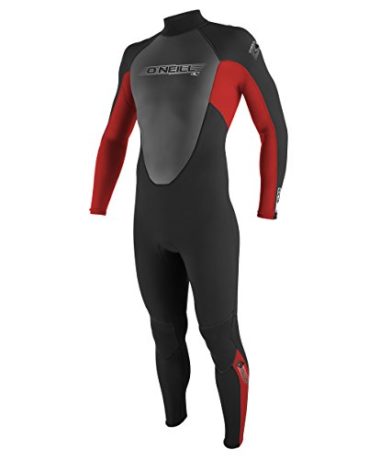
- Stand Out Features - Why We Love It
- Comfortable super seal neck with chafe-free edge
- Krypto Knee Pads improve wetsuit durability
- Strategic seamless zones improve arm movement
- Flatlock seams prevent rashing
- Easy-entry YKK zipper on the back
Material: Neoprene
Thickness: 3/2mm
Entry: Back
Length: Full
Sizes: XS to 3XL (tall and short models included)
EDITORS CHOICE
O’Neill Men’s Reactor 2 Wetsuit
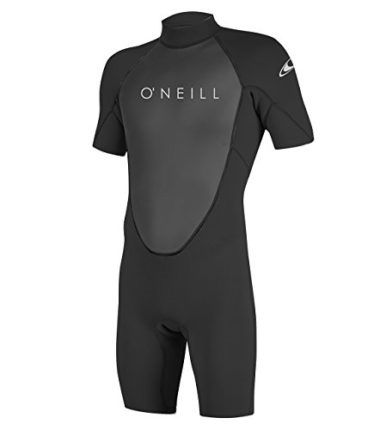
- Stand Out Features - Why We Love It
- FluidFlex 2 fabric keeps the core warm
- Neoprene is soft and incredibly elastic
- Wind-resistant smoothskin gives wind protection
- Water-resistant back closure
- Short raglan sleeves for better arm movement
Material: UltraStretch Neoprene (83% nylon, 17% spandex)
Thickness: 2mm
Entry: Back
Length: Short
Sizes: XS to 3XL (tall and short models included)
BEST VALUE
Seavenger Shorty Ultra Flexible Wetsuit
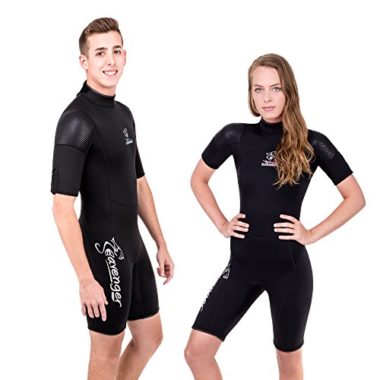
- Stand Out Features - Why We Love It
- Premium-quality neoprene construction
- Extra-flexible armpit panels improve movement
- Anti-abrasion pads on shoulders
- Long zipper leash for easier entry and exit
- Flat seams prevent skin irritation
Material: Nylon II neoprene
Thickness: 3mm
Entry: Back
Length: Short
Sizes: XS to 5XL (Men), 5 to 15 (Women)
Dark Lightning Premium CR Neoprene Wetsuit
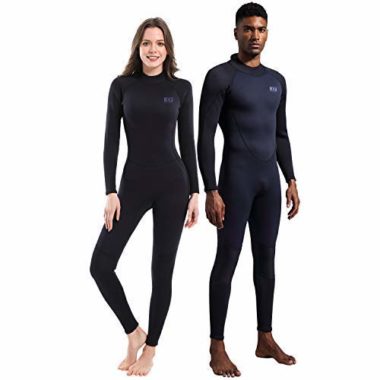
- Stand Out Features - Why We Love It
- Top-quality chloroprene construction
- Two thickness options available
- Highly elastic and flexible
- Tight fit for better performance
- 30-day money-back guarantee
Material: Chloroprene Rubber (90% neoprene, 10% stretch nylon)
Thickness: 3/2mm and 5/4mm
Entry: Back
Length: Full
Sizes: 2XS to 3XL
Lemorecn Premium Neoprene Wetsuit
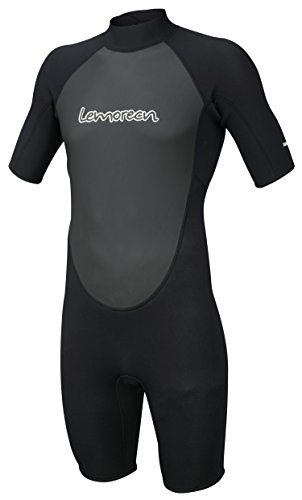
- Stand Out Features - Why We Love It
- Spot-taped seams increase durability
- High-quality #10 YKK zipper
- Extra-long leash on the zipper
- Anatomically cut for a snug fit
Material: Premium neoprene
Thickness: 3mm
Entry: Back
Length: Short
Sizes: S to 3XL (4 to 14)
Phantom Aquatics Men’s Marine Shorty Wetsuit
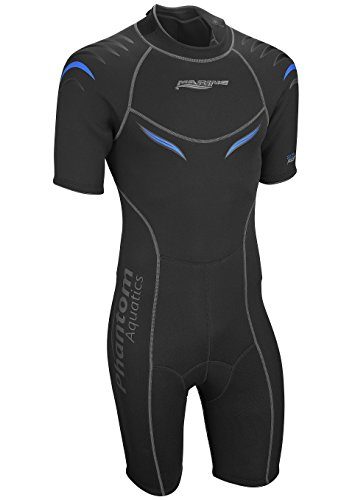
- Stand Out Features - Why We Love It
- Extra-durable Nylon II neoprene material
- Anatomically sculpted for a better fit
- Flatlock seams prevent skin irritation
- High-friction seat prevents slipping when seated
- Adjustable Velcro fastener on the neck
Material: Nylon II Neoprene
Thickness: 2.5mm
Entry: Back
Length: Short
Sizes: S to 3XL
O’Neill Women’s Reactor Wetsuit
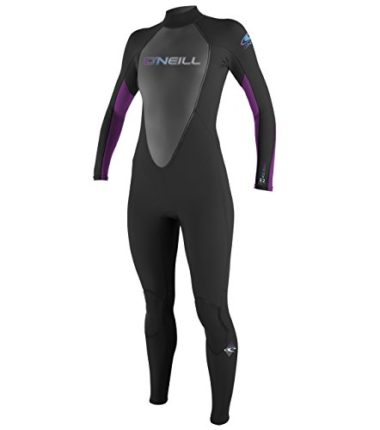
- Stand Out Features - Why We Love It
- Perfectly shaped for a female body
- Watertight zipper closure in the back
- FluidFlex fabric keeps body core warm
- Krypto Knee Padz reduce abrasion
- Double super seal neck for extra warmth
Material: Neoprene (95% nylon, 5% spandex)
Thickness: 3/2mm
Entry: Back
Length: Full
Sizes: 4 to 16
Quiksilver Men’s Syncro Steamer Wetsuit
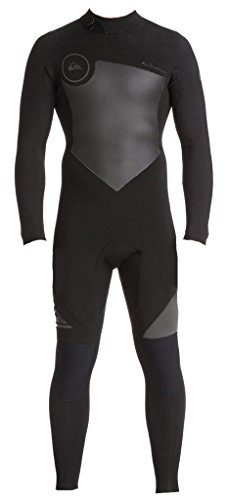
- Stand Out Features - Why We Love It
- Superior neoprene is 16% lighter than usual
- Thermal layer keeps the core warm and blocks wind
- Glued and blindstitched (GBS) seams keep water out
- Hydrowrap adjustable neck seal
- Reinforced knees prevent abrasion
Material: F’n LITE neoprene (16% lighter)
Thickness: 3/2mm
Entry: Back
Length: Full
Size: LT (large tall)
Myledi Neoprene Wetsuit
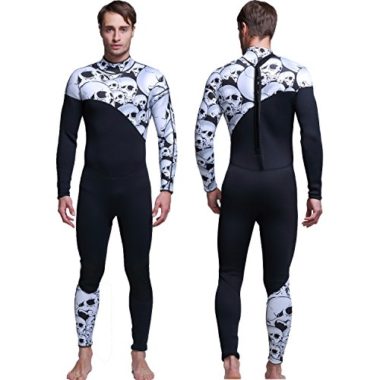
- Stand Out Features - Why We Love It
- Great-looking wetsuit print
- Laminated neoprene gives extra comfort
- Smooth cuff and ankle seals prevent water entry
- Flatlock seams prevent skin chafing
Material: Neoprene
Thickness: 3mm
Entry: Back
Length: Full
Sizes: S to 3XL
O’Neill Men’s Hammer Wetsuit
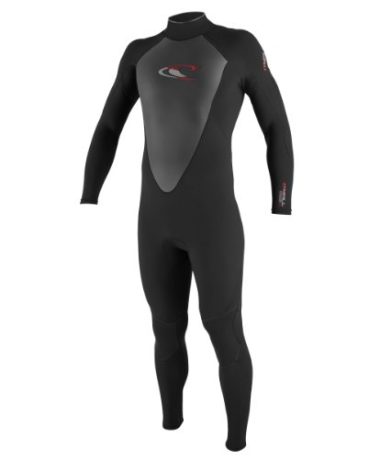
- Stand Out Features - Why We Love It
- Flatlock seams with seamless zones for chafe-free movement
- Smooth skin on chest and back improves comfort
- Double super seal neck prevents suit flushing
- High-quality #10 YKK zipper with a long leash
- Krypto Knee Padz improve durability
Material: Neoprene (83% nylon, 17% spandex)
Thickness: 3/2mm
Entry: Back
Length: Full
Sizes: S to 3XL (tall and short models included)
How To Choose The Best Surfing Wetsuit – Buying Guide

Durability
If you are serious about surfing, you are going to be wearing a surfing wetsuit<span style=”font-weight: 400;”> a lot. A wetsuit is going to be under a lot of strain, and it is going to take a beating from the elements (wind, rain).
To make sure your suit is durable, look for quality materials, good thickness, and the type of seams. For example, taped flat-lock seams work great on any wetsuit. Additionally, the best way to check the quality before you buy a suit is to check out the user reviews.
Seal
When thinking about seals, you should be thinking about the main areas where the wetsuit will seal against your body: the neck, the wrists, and the ankles. You do not want to skimp when it comes to this, as this is the main barrier against water. In addition, seal areas should also be flexible and comfortable. Look for seals that can be adjusted or seals that have been manufactured with comfort and safety in mind.
Material
High-quality neoprene is what we would recommend for your wetsuit, though you can also find other high-quality materials (chloroprene for example). New and improved materials for wetsuits are constantly being introduced, and more natural fibers are also available. However, neoprene gives the best balance between flexibility, comfort, and price.
You might also like: Surf Hair Products
Flexibility
As a surfer, your body will move a lot while you’re on the surfboard. This is why you want a surfing wetsuit which you can wear for a long period of time, and wear comfortably. Look for a wetsuit with high flexibility as a feature. If in doubt, go for neoprene.
Fit
Finding the right wetsuit size is very important for its function. The wrong size can be constricting and uncomfortable, or can be leaky and irritating. To know your size, you should visit a surfing (or water sports) store and try some suits on. Once you know your size, you can use the information to take advantage of the online prices. Make sure to check the reviews to weed out any suits which do not fit well or are advertised at the wrong size.
FAQs
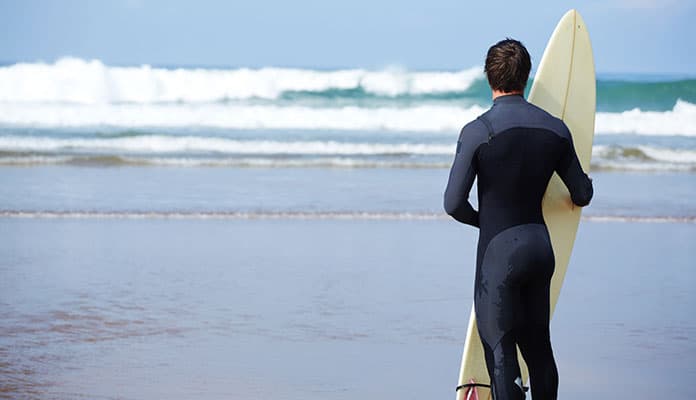
Q: What Are Wetsuits Made Of?
Wetsuits are made of neoprene, a synthetic rubber that traps water and helps keep you warm. Wetsuits also contain a high percentage of spandex, allowing them to be elastic so you can move freely. Neoprene thickness determines how warm your wetsuit is going to be, so be careful when choosing.
Related Review: WetsuitsQ: How Tight Should A Wetsuit Be?
A wetsuit should fit snug and tight (but not too much). This allows the wetsuit to do its job and keep you warm. The wetsuit traps a thin layer of water under it, allowing your body to warm it up so it can work as an insulator. A suit that is too loose allows too much water in (suit flushing), while a wetsuit that is too tight can be very uncomfortable to wear.
Q: Do Wetsuits Stretch When Wet?
Yes, every neoprene suit stretches a little when wet. They stick to the body when dry, and a little looser when water gets in. This doesn’t have to be much, but it will certainly make moving a bit easier. In addition, your wetsuit will stretch over time too.
Q: What Thickness Wetsuit Do I Need?
Wetsuit thickness depends on the conditions you’ll be surfing in. If you’re surfing in a warmer climate with temperatures ranging from 65°- 75°F, a 2mm wetsuit with short sleeves will do a great job. The colder it is, the thicker your suit should be. A 3-4mm suit works for temperatures from 50-65°F, while you will need a 5-6mm suit if it’s under 50°F. In addition, remember to factor in the wind speed, activity level, and your own personal sensitivity to cold.
Q: What Do You Wear Under A Wetsuit?
If you’re a guy, you can wear board shorts or diving shorts and a rash guard under your wetsuit. If you’re a girl, you can wear diving shorts, rash guards, and even one-piece bathing suits. Both men and women can wear full-body jumpsuits too.
While some divers choose to go commando, this can be uncomfortable because the suit chafes on the skin too much. In addition to comfort, wearing something underneath the wetsuit allows you to take the suit off when you’re done even if you’re in public.
Q: How To Clean A Wetsuit?
Fill a tub with cold or warm water (but not hot), and stir in the special wetsuit shampoo (or a mild solution of baking soda). Open the zippers on your suit, turn it inside out, and soak it in water. Knead it thoroughly with your fingers and leave it in for a while. Afterward, rinse the suit thoroughly with fresh water and hang it to dry.
Q: How To Dry A Wetsuit?
You should always leave your suit to air dry – never put it in a dryer. Also, don’t leave it to dry in the sun because sunshine can damage the neoprene. When drying, it’s important to dry both sides. When you rinse it hang it to dry on one side and leave it. After a while, you can press on the arms and legs to drain out excess water.
When the first side is dry, turn it inside-out and let the other side dry too. Depending on suit thickness, it will take from under a day to a couple of days for the suit to fully dry.
Q: How To Dry A Wetsuit?
This depends on a women’s build. If a woman is leaner and doesn’t have large breasts, she can usually fit in a men’s wetsuit just fine. In addition, the elasticity of neoprene in high-quality suits allows it to adapt to any body shape.
However, men’s wetsuits won’t be an ideal fit for the majority of women. Wetsuits are made to be snug, and women’s wetsuits follow the natural lines of a female body. This is why a true women’s wetsuit will always be a better fit for a woman.
Related Review: Women WetsuitsQ: Why Do You Surf In A Wetsuit?
Wetsuits are mainly worn to keep you warm by trapping a thin layer of water between you and the suit. This thin layer of water is then warmed by your body and keeps you warm. Even in the warmest climates, the water can be cold when you are in it all day.
The other advantages of a wetsuit are:
- They will stay on even when you fall off your board. They will not bunch up or come off like loose t-shirts and other clothing.
- They provide a buffer between you and the water. When you fall off your board, a wetsuit will absorb some of the impact.
- They are extremely flexible.
Q: How To Put On A Surf Wetsuit?
Wetsuits are tight and for good reason. They can be tricky to put on if you do not know what you are doing. Follow our simple steps to have your suit on in no time:
- Put on any protective gear first.
- Unzip the wetsuit (make sure that it is fully unzipped).
- Line up your wetsuit with your body and put your legs and feet in first. Work from the bottom of your feet up to your thigh, making sure that there are no kinks or folds. Do one leg at a time.
- Pull the suit over your hips and torso. Jump up and down a little to make sure the fit is tight and comfortable.
- Insert one arm at a time. Watch out for long fingernails; you do not want to rip the suit.
- Have someone zip you up if needed, or use the long leash which comes attached to most new wetsuits.
- Lock the fasteners over the zip.
Move around to make sure the suit is comfortable and adjust the fit if needed.
Globo Surf Overview
Surfing can be enjoyed by anyone, as long as you are willing to make that leap of faith into the water. If you are ready to do that, you will need a wetsuit to give you protection. Hopefully, our guide gave you some useful information to make your choice easier. Taking your time and finding the perfect surfing wetsuit will make your surfing experience the best it can be.
More Surp Sport Gear Reviews:
- Cameras For Surfing
- Balance Boards For Surfing
- Gifts For Surfers
- Surf Bikinis
- Rash Guard
- Sunscreen for Surfing and Watersports
- Surf Earplugs
- Surf Watches
More Wetsuits Reviews:
Have you tried one of our best surfing wetsuits? Let us know how you like it in the comment section below.

